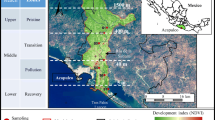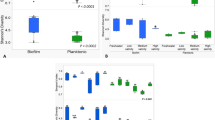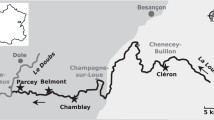Abstract
The information content and responsiveness of microbial biofilm community structure, as an integrative indicator of water quality, was assessed against short-term changes in oxygen and nutrient loading in an open-water estuarine setting. Biofilms were grown for 7-day periods on artificial substrates in the Pensacola Bay estuary, Florida, in the vicinity of a wastewater treatment plant (WWTP) outfall and a nearby reference site. Substrates were deployed floating at the surface and near the benthos in 5.4 m of water. Three sampling events covered a 1-month period coincident with declining seasonal WWTP flow and increasing dissolved oxygen (DO) levels in the bottom waters. Biomass accumulation in benthic biofilms appeared to be controlled by oxygen rather than nutrients. The overriding effect of DO was also seen in DNA fingerprints of community structure by terminal restriction fragment length polymorphism (T-RFLP) of amplified 16S rRNA genes. Ribotype diversity in benthic biofilms at both sites dramatically increased during the transition from hypoxic to normoxic. Terminal restriction fragment length polymorphism patterns showed pronounced differences between benthic and surface biofilm communities from the same site in terms of signal type, strength, and diversity, but minor differences between sites. Sequencing of 16S rRNA gene clone libraries from benthic biofilms at the WWTP site suggested that low DO levels favored sulfate-reducing prokaryotes (SRP), which decreased with rising oxygen levels and increasing overall diversity. A 91-bp ribotype in the CfoI-restricted 16S rRNA gene T-RFLP profiles, indicative of SRP, tracked the decrease in relative SRP abundance over time.







Similar content being viewed by others
References
Abed, RMM, Safi, NMD, Köster, J, De Beer, D, El-Nahhal, Y, Rullkötter, J, Garcia-Pichel, F (2002) Microbial diversity of a heavily polluted microbial mat and its community changes following degradation of petroleum compounds. Appl Environ Microbiol 68: 1674–1683
Balba, MT, Nedwell, DB (1982) Microbial metabolism of acetate, propionate and butyrate in anoxic sediments from the Colne Point saltmarsh, Essex, UK. J Gen Microbiol 128: 1415–1422
Bordenave, S, Fourçans, A, Blanchard S, Goñi, MS, Caumette, P, Duran, R (2004) Structure and functional analyses of bacterial communities changes in microbial mats following petroleum exposure. Ophelia 58: 195–204
Brakenhoff, RH, Schoenmakers, JGG, Lubsen, NH (1991) Chimeric cDNA clones: a novel PCR artifact. Nucleic Acids Res 19: 1949
Brigmon, RL, Martin, HW, Morris, TL, Britton, G, Zam, SG (1994) Biogeochemical ecology of Thiothrix spp. in underwater limestone caves. Geomicrobiol J 12: 141–159
Brinkhoff, T, Muyzer, G, Wirsen, CO, Kuever, J (1999) Thiomicrospira kuenenii sp. nov. and Thiomicrospira frisia sp. nov., two mesophilic obligately chemolithoautotrophic sulfur-oxidizing bacteria isolated from an intertidal mud flat. Int J Syst Bacteriol 49: 385–392
Brinkhoff, T, Muyzer, G, Wirsen, CO, Kuever, J (1999) Thiomicrospira chilensis sp. nov., a mesophilic obligately chemolithoautotrophic sulfur-oxidizing bacterium isolated from a Thioploca mat. Int J Syst Bacteriol 49: 875–879
Cavanaugh, CM (1983) Symbiotic chemoautotrophic bacteria in marine invertebrates from sulphide-rich habitats. Nature 302: 58–61
Crump, BC, Baross, JA (1996) Particle-attached bacteria and heterotrophic plankton in the Columbia River estuary. Mar Ecol Prog Ser 138: 265–273
Crump, BC, Simenstad, CA, Baross, JA (1998) Particle-attached bacteria dominate the Columbia River estuary. Aquat Microb Ecol 14: 7–18
Cypionka, H, Widdel, F, Pfennig, N (1985) Survival of sulfate-reducing bacteria after oxygen stress growth in sulfate-free oxygen-sulfide gradients. FEMS Microbiol Ecol 31: 39–45
Distel, DL, Lane, DJ, Olsen, GJ, Giovanni, SJ, Pace, B, Pace, NR, Stahl, DA, Felbeck, H (1988) Sulfur-oxidizing bacterial endosymbionts: analysis of phylogeny and specificity by 16S rRNA sequences. J Bacteriol 170: 2506–2510
Eaton, AD, Clesceri, LS, Greenberg, AE (1995) Standard Methods for the Examination of Water and Wastewater, 19th edn. American Public Health Association; American Water Works Association; Water Environment Federation, Washington, D.C.
Felbeck, H, Childress, JJ, Somero, GN (1981) Calvin–Benson cycle and sulphide oxidation enzymes in animals from sulphide-rich habitats. Nature 293: 291–293
Fenchel, T (1969) The ecology of marine microbenthos IV. Structure and function of the benthic ecosystem, its chemical and physical factors and the microfauna communities with special reference to the ciliated Protozoa. Ophelia 6: 1–182
Fenchel, T, Perry, T, Thane, A (1977) Anaerobiosis and symbiosis with bacteria in free-living ciliates. J Protozool 24: 154–163
Fisher, MR, Hand, SC (1984) Chemoautotrophic symbionts in the bivalve Lucina floridana from seagrass beds. Biol Bull 167: 445–459
Friedrich, CG, Rother, D, Bardischewsky, F, Quentmeier, A, Fischer, J (2001) Oxidation of reduced inorganic sulfur compounds by bacteria: emergence of a common mechanism? Appl Environ Microbiol 67: 2873–2882
Ito, T, Sugita, K, Okabe, S (2004) Isolation, characterization, and in situ detection of a novel chemolithoautotrophic sulfur-oxidizing bacterium in wastewater biofilms growing under microaerophilic conditions. Appl Environ Microbiol 70: 3122–3129
Johnson, MA, Diouris, M, Le Pennec, M (1994) Endosymbiotic bacterial contribution in the carbon nutrition of Loripes lucinalis (Mollusca: Bivalvia). Symbiosis 17: 1–13
Jørgensen, BB, Bak, F (1991) Pathways and microbiology of thiosulfate transformations and sulfate reduction in a marine sediment (Kattegat, Denmark). Appl Environ Microbiol 57: 847–856
Lane, DJ (1991) 16S/23S rRNA sequencing. In: Stackebrandt, E, Goodfellow, M (Eds.) Nucleic Acid Techniques in Bacterial Systematics, John Wiley & Sons, Chichester, United Kingdom, pp 115–175
Lens, PN, De Poorter, M-P, Cronenberg, CC, Verstraete, WH (1995) Sulfate reducing and methane producing bacteria in aerobic wastewater treatment systems. Water Res 29: 871–880
Liesack, W, Weyland, H, Stackebrandt, E (1991) Potential risks of gene amplification by PCR as determined by 16S rDNA analysis of a mixed-culture of strict barophilic bacteria. Microb Ecol 21: 191–198
McCune, B, Mefford, MJ (1999) PC-ORD: Multivariate Analysis of Ecological Data. MjM Software Design, Gleneden Beach, Oregon, USA
Minz, D, Fishbain, S, Green, SJ, Muyzer, G, Cohen, Y, Rittmann, BE, Stahl, DA (1999) Unexpected population distribution in a microbial mat community: sulfate-reducing bacteria localized to the highly oxic chemocline in contrast to a eukaryotic preference for anoxia. Appl Environ Microbiol 65: 4659–4665
Minz, D, Flax, JL, Green, SJ, Muyzer, G, Cohen, Y, Wagner, M, Rittmann, BE, Stahl, DA (1999) Diversity of sulfate-reducing bacteria in oxic and anoxic regions of a microbial mat characterized by comparative analysis of dissimilatory sulfite reductase genes. Appl Environ Microbiol 65: 4666–4671
Moss, JA, Nocker, A, Lepo, JE, Snyder, RA (2006) Stability and change in estuarine biofilm bacterial community diversity. Appl Environ Microbiol 72: 5679–5688
Navarrete, A, Urmenta, J, Cantu, JM, Vegas, E, White, DC, Guerrero, R (2004) Signature lipid biomarkers of microbial mats of the Ebro Delta (Spain), Camargue and Étang (France): an assessment of biomass and activity. Ophelia 58: 175–188
Nelson, DC, Fisher, CR (1995) Chemoautotrophic and methanotrophic endosymbiotic bacteria at deep-sea vents and seeps. In: Karl, DM (Ed.) The Microbiology of Deep-Sea Hydrothermal Vents, CRC Press, Boca Raton, FL, pp 125–167
Nocker, A, Lepo, JE, Snyder, RA (2004) Influence of an oyster reef on development of the microbial heterotrophic community of an estuarine biofilm. Appl Environ Microbiol 70: 6834–6845
Okabe, S, Itoh, T, Satoh, H (2003) Sulfate-reducing bacterial community structure and their contribution to carbon mineralization in a wastewater biofilm growing under microaerophilic conditions. Appl Microbiol Biotechnol 63: 322–334
Okabe, S, Itoh, T, Satoh, H, Watanabe, Y (1999) Analyses of spatial distributions of sulfate-reducing bacteria and their activity in aerobic wastewater biofilms. Appl Environ Microbiol 65: 5107–5116
Purdy, KJ, Munson, MA, Embley, TM, Nedwell, DB (2003) Use of 16S rRNA-targeted oligonucleotide probes to investigate function and phylogeny of sulfate-reducing bacteria and methanogenic archaea in a UK estuary. FEMS Microbiol Ecol 44: 361–371
Purdy, KJ, Embley, TM, Nedwell, DB (2002) The distribution and activity of sulphate reducing bacteria in estuarine and coastal marine sediments. Antonie Van Leeuwenhoek 8: 181–187
Purdy, KJ, Nedwell, DB, Embley, TM, Takii, S (2001) Using 16S rRNA-targeted oligonucleotide probes to investigate the distribution of sulphate-reducing bacteria in a Japanese estuary. FEMS Microbiol Ecol 36: 165–168
Reid, R (1980) Aspects of the biology of a gutless species of Solemya (Bivalvia: Protobranchia). Can J Zool 58: 386–393
Rinke, C, Schmitz-Esser, S, Stoecker, K, Nussbaumer, AD, Molnár, DA, Vanura, Wagner, KM, Horn, M, Ott, JA, Brigh, M (2006) “Candidatus Thiobios zoothamnicoli,” an ectosymbiotic bacterium covering the giant marine ciliate Zoothamnium niveum. Appl Environ Microbiol 72: 2014–2021
Röling, WFM, Milner, MG, Martin Jones, D, Fratepietro, F, Swannell, RPJ, Daniel, F, Head, IM (2004) Bacterial community dynamics and hydrocarbon degradation during a field-scale evaluation of bioremediation on a mudflat beach contaminated with buried oil. Appl Environ Microbiol 70: 2603–2613
Santegoeds CM, Ferdelman, TG, Muyzer, G, de Beer, D (1998) Structural and functional dynamics of sulfate-reducing populations in bacterial biofilms. Appl Environ Microbiol 64: 3731–3739
Sarbu, SM, Kinkle, BK, Vlasceanu, L, Kane, TC, Popa, R (1994) Microbiological characterization of a sulfide-rich groundwater ecosystem. Geomicrobiol J 12: 175–182
Schramm, A, Larsen, LH, Revsbech, NP, Ramsing, NB, Amann, R, Schleifer, K-H (1996) Structure and function of a nitrifying biofilm as determined by in situ hybridization and the use of microelectrodes. Appl Environ Microbiol 62: 4641–4647
Sievert, SM, Heidorn, T, Kuever, J (2000) Halothiobacillus kellyi sp. nov., a mesophilic, obligately chemolithoautotrophic, sulfur-oxidizing bacterium isolated from a shallow-water hydrothermal vent in the Aegean sea, and emended description of the genus Halothiobacillus. Int J Syst Evol Microbiol 50: 1229–1237
Snyder, RA, Lewis, MA, Nocker, A, Lepo, JE (2004) Microbial biofilms as integrative sensors of environmental quality. In: Bortone, SA (Ed.) Estuarine Indicators, CRC Press, Boca Raton, FL, pp 111–126
Urakawa, H, Yoshida, T, Nishimura, M, Ohwada, K (2001) Characterization of microbial community in surface marine sediments using terminal restriction fragment length polymorphism (T-RFLP) analysis and quinone profiling. Mar Ecol Prog Ser 220: 47–57
U.S. Environmental Protection Agency (1997) Revision to Rapid Bioassessment Protocols for Use in Streams and Rivers: Periphyton, Benthic Macroinvertebrates, and Fish. EPA 841-D-97-002. United States Environmental Protection Agency, Washington, D.C.
Widdel, F, Bak, F (1992) Gram-negative mesophilic sulfate-reducing bacteria. In: Balows, A, Trüper, HG, Dworkin, M, Harder, W, Schleifer, K-H (Eds.) The Procaryotes: A Handbook on the Biology of Bacteria: Ecophysiology, Identification, Application, Springer-Verlag, NY
Winfrey, MR, Ward, DM (1983) Substrates for sulfate reduction and methane production in intertidal sediments. Appl Environ Microbiol 45: 193–199
Wu, J (1999) A generic index of diatom assemblages as bioindicator of pollution in the Keelung River of Taiwan. Hydrobiologia 397: 79–87
Acknowledgments
We thank Jeff Alison, Laura Pennington, Natasha Rondon, and Matt Wagner for their field assistance and Melissa Hagy for the data management.
This research was supported by a grant from the U.S. Environmental Protection Agency (US EPA)’s Science to Achieve Results (STAR) Estuarine and Great Lakes (EaGLe) Coastal Initiative through funding to the CEER-GOM Project, US EPA Agreement EPA/R-8294580.
Author information
Authors and Affiliations
Corresponding author
Rights and permissions
About this article
Cite this article
Nocker, A., Lepo, J.E., Martin, L.L. et al. Response of Estuarine Biofilm Microbial Community Development to Changes in Dissolved Oxygen and Nutrient Concentrations. Microb Ecol 54, 532–542 (2007). https://doi.org/10.1007/s00248-007-9236-z
Received:
Revised:
Accepted:
Published:
Issue Date:
DOI: https://doi.org/10.1007/s00248-007-9236-z




